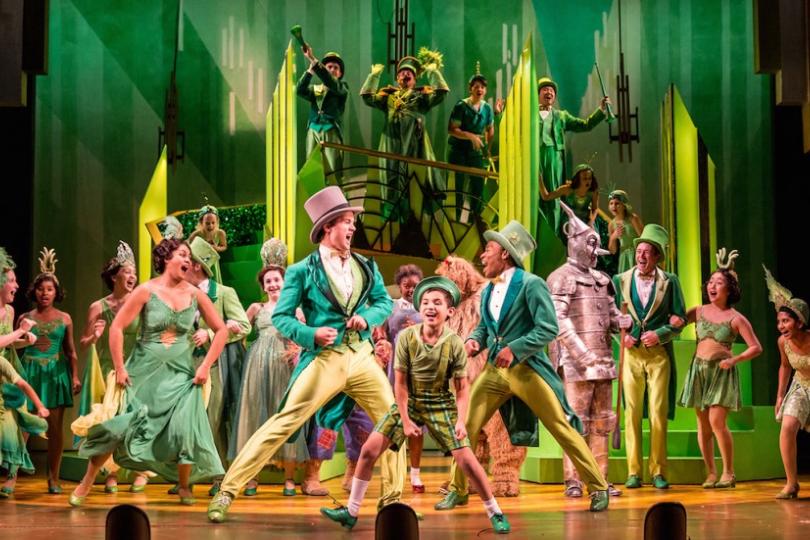The Wizard that always was and shall be

Let me say right up front that the Children’s Theatre’s new production of The Wizard of Oz is masterfully executed, a brightly colored, highly kinetic adaptation packed with impressive visual effects, ingenious set design and stunning costumery. It’s just about everything a Wizard of Oz fan could hope for in an adaptation, from the jaunty orchestral score to the playful choreography to the impeccably trained Toto. If you suspect you’d enjoy a Children’s Theatre presentation of The Wizard of Oz, I can confirm that you will almost certainly dig this one.
I lead with all of that because I don’t want to come off like I’m slagging on a production that was genuinely enjoyed by my whole family, including a five-year-old who went in anxious that the witch and the cyclone would be too scary and came out raving about the Cowardly Lion and humming “If I Only Had a Brain.” It’s a production that hits all the right notes with perfect pitch, and that’s where I, malcontent that I am, have a problem.
I wrote about this the last time a touring production of The Wizard of Oz came through town, when most of the local reviews gave the show credit for doing what it was supposed to. I understand the tendency to praise faithfulness to one of the most beloved and (arguably) most perfectly executed films of all time, but at what point do we start asking for more than faithfulness? Is there room for a Wizard of Oz that subverts our expectations? Taking liberties with Dorothy’s journey would likely provoke an outcry from diehard fans, but does that have to be a bad thing?
You can see it before you see it
When an iconic property is produced by an iconic company, the layers of expectation only become more pronounced. Chatting about the upcoming Wizard with a friend a couple of months ago, we were able to cast most of the roles without even seeing a program. Of course you’re going to have Dean Holt as the Scarecrow, Reed Sigmund as the Cowardly Lion, Gerald Drake as the Wizard and so on.
That casting makes complete sense, because each of those actors is tailor-made for the part. The Children’s Theater players are so reliable and their respective personas so ingrained in the consciousness of regular attendees that it would seem borderline heretical to cast the play any other way. Again, I fully understand the desire not to rock a boat that’s maybe the most seaworthy in town, but I can’t help wondering what we might discover in some choppier water.
In fairness, I should give Children’s Theatre credit for casting an actress of color as Dorothy. Traci Allen Shannon does a fine job, nailing her musical numbers and giving the story a sympathetic moral center, but the role as presented here is so deeply rooted in Judy Garland that it’s nigh impossible for Shannon to make it her own.
That raises another issue with adaptations as faithful as this one: the actors aren’t asked to play characters so much as they’re playing characters as played by other actors. That doesn’t make the performances any less memorable - these characters are part of our national consciousness for good reason - but it leaves me to wonder what these actors could do with a little more room to move. As much fun as it is to watch Reed Sigmund growl, “Put ‘em up, put ‘em up!” in spot-on Bert Lahr diction, I’d love to see the Cowardly Lion as more of a Reed Sigmund creation.
If it ain't broke. . .
I get that The Wizard of Oz is something of a unique property. Watching this production, I was struck by just how deeply the film is embedded in the American psyche. Scarcely a minute goes by without an image or line of dialogue that’s permeated the culture to the point that I’d forgotten where it came from in the first place.
It’s such a holy text that it’s easy to forget that the movie is itself a fairly liberal adaptation of L. Frank Baum’s splendid novel. The satire is softened, the character motivations are altered and the Wicked Witch looms considerably larger than she does on the page. Some of the book’s most striking passages were cut due to the era’s technical limitations, while other elements were added because they popped better on film - notably the famous ruby slippers, which were originally silver. And Baum’s creation still packs a punch, as shown by Marvel’s exceptional recent comics adaptation.
I’m not demanding that theater companies produce more Baum-centric renditions, just noting that there’s plenty of material to draw from without making a full-on, Wicked-style reimagining. Heck, Shakespeare’s been remixed, rewritten and transposed onto every imaginable time and place without his reputation taking a hit. Surely the Wizard and his friends could survive a little bit of tinkering.
Let me say one more time, because I feel like I’m contradicting myself all over the place - no matter how big a downer I’m being here, the Children’s Theater Wizard of Oz is really, really well done and you should probably go see it. I just can’t help feeling discomfited that the standard of success for this particular play is adherence to a firmly established vocabulary. On the other hand, my son has read the book and the comics but never seen the movie, and he adored this production. Clearly it ain’t all that broke, so who am I to demand its fixing?




